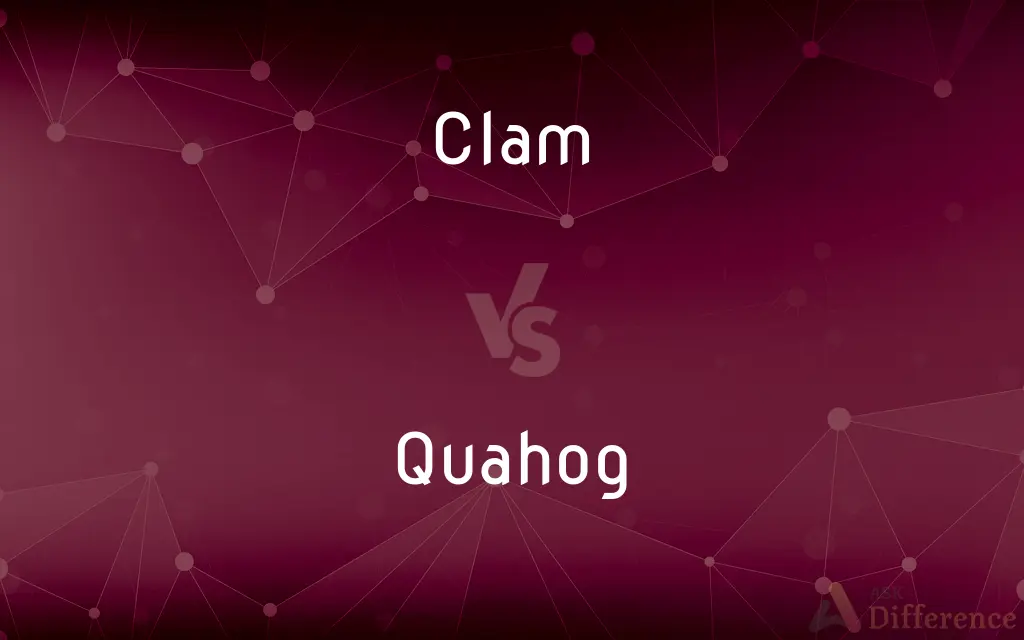Clam vs. Quahog — What's the Difference?
By Urooj Arif & Fiza Rafique — Updated on March 28, 2024
A clam is a general term for various bivalve mollusks, while a quahog is a specific type of hard-shell clam found in the Atlantic.

Difference Between Clam and Quahog
Table of Contents
ADVERTISEMENT
Key Differences
Clams encompass a broad category of bivalve mollusks found in both freshwater and saltwater environments. They are known for their two hinged shells and burrowing lifestyle. Quahogs, on the other hand, are a specific kind of hard-shell clam native to the East Coast of the United States, particularly known for their use in chowders and stuffings. While all quahogs are clams, not all clams are quahogs, highlighting the specificity of quahogs within the broader clam category.
Clams vary significantly in size, habitat, and lifespan, ranging from the tiny pea clam to the large geoduck. Quahogs are categorized based on their size, from little necks to chowders, each preferred for different culinary uses. This size distinction among quahogs showcases their culinary versatility and importance, distinguishing them within the diverse world of clams.
While clams can be found globally, quahogs are specifically associated with the Atlantic coast of North America. Their habitat influences their flavor and texture, making quahogs particularly prized in regional cuisines. The distinction in habitat not only affects their culinary uses but also their cultural significance, with quahogs holding a special place in New England and Native American traditions.
In terms of culinary use, clams are used in a wide variety of dishes around the world, from Italian vongole to Japanese miso soup. Quahogs, with their distinct size categories, are especially favored in American cuisine, from raw bar selections to hearty stews. This culinary preference further underscores the unique status of quahogs among clams.
Understanding the difference between clams and quahogs is essential for both culinary professionals and enthusiasts. Recognizing that quahogs represent a specific subset of clams enriches one's appreciation for the diversity of seafood available and its regional distinctions.
ADVERTISEMENT
Comparison Chart
Definition
A broad category of bivalve mollusks with a hinged shell.
A specific type of hard-shell clam from the Atlantic coast.
Varieties
Includes many species, such as soft-shell clams, razor clams, and geoducks.
Categorized by size, including little necks, top necks, cherry stones, and chowders.
Habitat
Found in freshwater and saltwater environments worldwide.
Predominantly found in the Atlantic Ocean, especially in North America.
Culinary Uses
Used in a variety of international dishes, adaptable to many cooking methods.
Highly valued in American cuisine, often used in chowders and stuffings.
Cultural Significance
Varies widely across different cultures and cuisines.
Holds particular importance in New England and Native American traditions.
Compare with Definitions
Clam
A diverse group of bivalve mollusks, often enjoyed steamed, boiled, or in chowders.
The clam bake on the beach was a summer highlight.
Quahog
Native to the Atlantic, playing a key role in regional dishes.
Stuffed quahogs were a family recipe passed down through generations.
Clam
Can live in various habitats, contributing to their wide culinary use.
Freshwater clams from the lake were used in the soup.
Quahog
Symbolic in certain cultures, with shells used historically as currency.
Quahog shells were carved into wampum beads by Native Americans.
Clam
Often harvested both commercially and recreationally.
They went clamming at low tide for the evening's dinner.
Quahog
A type of hard-shell clam known for its larger size and meaty texture.
The quahog chowder had a rich, briny flavor.
Clam
Known for their soft and sometimes chewy texture.
The pasta featured clams in a white wine sauce.
Quahog
Classified by size, affecting their use in cooking.
Little neck quahogs are perfect for raw consumption.
Clam
Clams serve as a significant food source and ecosystem component.
The health of the clam population indicates the water's quality.
Quahog
Integral to New England seafood cuisine.
Quahogs are a staple in Rhode Island clam cakes.
Clam
Clam is a common name for several kinds of bivalve molluscs. The word is often applied only to those that are edible and live as infauna, spending most of their lives halfway buried in the sand of the seafloor or riverbeds.
Quahog
An edible clam (Mercenaria mercenaria) of the Atlantic coast of North America, having a hard rounded shell. Also called hard-shell clam, round clam.
Clam
A marine bivalve mollusc with shells of equal size.
Quahog
An edible clam with a hard shell found along the Atlantic Coast of North America, from species Mercenaria mercenaria, formerly Venus mercenaria.
Clam
A dollar.
Quahog
The largest size of such an edible clam, generally considered only fit for use in chowders and other clam dishes.
Clam
Dig for or collect clams
November is one of the worst times for clamming
Quahog
A similar edible clam found along coasts around the North Atlantic, generally in deeper waters, the ocean quahog, black quahog, mahogany clam or Icelandic cyprine, Arctica islandica
Clam
Abruptly stop talking
As soon as I ask if any of this can go on the record, he clams up
Quahog
(intransitive) To dig for quahogs.
Clam
Any of various usually burrowing marine and freshwater bivalve mollusks chiefly of the subclass Heterodonta, including members of the families Veneridae and Myidae, many of which are edible.
Quahog
An American market clam (Venus mercenaria). It is sold in large quantities, and is highly valued as food. Called also round clam, and hard clam.
Clam
The soft edible body of such a mollusk.
Quahog
Atlantic coast round clams with hard shells; large clams usually used for chowders or other clam dishes
Clam
(Informal) A close-mouthed person, especially one who can keep a secret.
Quahog
An edible American clam
Clam
(Slang) A dollar
Owed them 75 clams.
Clam
A clamp or vise.
Clam
To hunt for clams.
Clam
A bivalve mollusk of many kinds, especially those that are edible; for example pl=s (Mya arenaria), hard clams (Mercenaria mercenaria), sea clams or hen clam (Spisula solidissima), and other species. The name is said to have been given originally to the Tridacna gigas, a huge East Indian bivalve.
Clam
Strong pincers or forceps.
Clam
A kind of vise, usually of wood.
Clam
A dollar.
Those sneakers cost me fifty clams!
Clam
A Scientologist.
Clam
A vagina.
Clam
(slang) In musicians' parlance, a wrong or misplaced note.
Clam
(informal) One who clams up; a taciturn person, one who refuses to speak.
Clam
Mouth (Now found mostly in the expression shut one's clam)
Clam
Clamminess; moisture
Clam
To dig for clams.
Clam
To produce, in bellringing, a clam or clangor; to cause to clang.
Clam
To be moist or glutinous; to stick; to adhere.
Clam
To clog, as with glutinous or viscous matter.
Clam
Clammy.
Clam
A bivalve mollusk of many kinds, especially those that are edible; as, the long clam (Mya arenaria), the quahog or round clam (Venus mercenaria), the sea clam or hen clam (Spisula solidissima), and other species of the United States. The name is said to have been given originally to the Tridacna gigas, a huge East Indian bivalve.
You shall scarce find any bay or shallow shore, or cove of sand, where you may not take many clampes, or lobsters, or both, at your pleasure.
Clams, or clamps, is a shellfish not much unlike a cockle; it lieth under the sand.
Clam
Strong pinchers or forceps.
Clam
A kind of vise, usually of wood.
Clam
Claminess; moisture.
Clam
A crash or clangor made by ringing all the bells of a chime at once.
Clam
To clog, as with glutinous or viscous matter.
A swarm of wasps got into a honey pot, and there they cloyed and clammed Themselves till there was no getting out again.
Clam
To be moist or glutinous; to stick; to adhere.
Clam
To produce, in bell ringing, a clam or clangor; to cause to clang.
Clam
Burrowing marine mollusk living on sand or mud
Clam
A piece of paper money worth one dollar
Clam
Flesh of either hard-shell or soft-shell clams
Clam
Gather clams, by digging in the sand by the ocean
Common Curiosities
How do you distinguish between clams and quahogs?
Clams refer to a broad category of bivalve mollusks, while quahogs are a specific, larger, hard-shell variety found in the Atlantic.
What exactly is a quahog?
A quahog is a specific type of hard-shell clam native to the Atlantic coast, valued for its culinary uses.
Can you eat quahogs raw?
Yes, smaller quahogs, like little necks, are often eaten raw, similar to oysters.
What makes quahogs unique among clams?
Quahogs are unique for their hard shell, larger size, specific habitat, and significant cultural and culinary value, especially in the Atlantic region.
Are quahogs good for your health?
Quahogs, like other shellfish, are nutritious, offering a good source of protein, minerals, and omega-3 fatty acids, though consumption should be mindful of dietary restrictions and potential allergens.
Why are quahogs important in New England cuisine?
Quahogs hold a special place in New England cuisine due to their availability, taste, and versatility in dishes like chowders and stuffings.
What are the size categories of quahogs?
Quahogs are categorized by size into little necks, top necks, cherry stones, and chowders, each preferred for different culinary applications.
Is there a difference in taste between clams and quahogs?
Yes, quahogs typically have a stronger, brinier flavor compared to other clams, partly due to their habitat and size.
Do quahogs have any predators?
Quahogs face predation from various marine animals, including starfish, crabs, and birds, as well as humans.
What is the environmental impact of clamming?
Sustainable clamming practices are important for maintaining healthy ecosystems, as overharvesting can damage habitats and reduce biodiversity.
Can clams and quahogs be used interchangeably in recipes?
While they can sometimes be substituted for each other, differences in texture and flavor may affect the outcome of certain dishes.
Are all clams suitable for chowder?
While many clams can be used in chowder, quahogs are particularly prized for this purpose due to their flavor and texture.
How are clams harvested?
Clams can be harvested in various ways, including digging, raking, or dredging, depending on the species and habitat.
How long do quahogs live?
Quahogs can live for several decades, with their age often indicated by the rings on their shells.
Why are clams and quahogs important to ecosystems?
They play crucial roles in aquatic ecosystems, including filtering water, providing habitat, and serving as a food source for other species.
Share Your Discovery

Previous Comparison
Pier vs. Pylon
Next Comparison
Ouzo vs. TsipouroAuthor Spotlight
Written by
Urooj ArifUrooj is a skilled content writer at Ask Difference, known for her exceptional ability to simplify complex topics into engaging and informative content. With a passion for research and a flair for clear, concise writing, she consistently delivers articles that resonate with our diverse audience.
Co-written by
Fiza RafiqueFiza Rafique is a skilled content writer at AskDifference.com, where she meticulously refines and enhances written pieces. Drawing from her vast editorial expertise, Fiza ensures clarity, accuracy, and precision in every article. Passionate about language, she continually seeks to elevate the quality of content for readers worldwide.
















































